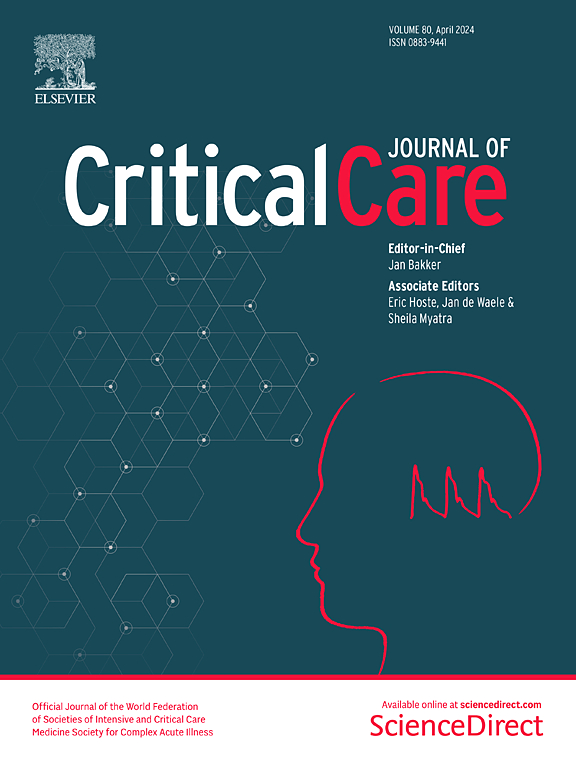改良的全球疾病负担国际疾病分类编码方法识别败血症的准确性:一项前瞻性多中心队列研究
IF 8.8
1区 医学
Q1 CRITICAL CARE MEDICINE
引用次数: 0
摘要
本研究评估了来自全球疾病负担(GBD)败血症研究(改进的GBD方法)的三种国际疾病分类(ICD)代码方法在识别败血症方面的准确性,并与Angus方法进行了比较。本文还报道了这些方法的误差来源。前瞻性多中心观察性研究。来自澳大利亚新南威尔士州9家医院的年龄≥16岁的高脓毒症风险急诊科患者使用脓毒症3标准进行临床脓毒症筛查,并使用改进的GBD和Angus方法将其编码为脓毒症或非脓毒症。三种改进的GBD方法是:记录显性败血症特异性ICD代码;隐性败血症特异性编码或感染作为主要ICD编码加器官功能障碍编码;隐式+ - as表示隐式但感染为主要或次要ICD代码。采用Cronbach alpha (α)评价临床败血症与ICD编码方法之间的一致性。对于假阳性病例(ICD编码的败血症但未临床诊断),记录导致这些错误的ICD编码。对于假阴性(临床诊断败血症但icd编码),未编码的感染源和器官功能障碍被记录。6869例筛查患者中,450例(中位年龄72.4岁,48.9%为女性)符合纳入标准。临床败血症患者215/450(47.8%)。外显法、内隐法、内隐加法和Angus法分别为108/450(24.0%)、175/450(38.9%)、222/450(49.3%)和170/450(37.8%)。敏感性分别为41.4%、58.1%、67.4%和55.8%,特异性分别为91.9%、78.7%、67.2%和79.1%。临床败血症与所有ICD编码方法的一致性较低(α = 0.52 ~ 0.56)。假阳性分别为19、50和77,假阴性分别为126、90和70。对于假阳性病例,未明确的尿路感染、低血压和急性肾衰竭通常被指定为感染和器官功能障碍代码。约一半(44.3% ~ 55.6%)的假阴性病例没有病原体记录。改进的GBD方法对脓毒症的识别准确率较低;隐式加号法是最精确的。使用ICD编码识别败血症的错误主要来自未指明的泌尿系统感染和相关器官功能障碍的编码。该研究于2021年3月24日在ANZCTR注册(ACTRN12621000333819)。本文章由计算机程序翻译,如有差异,请以英文原文为准。
Accuracy of the modified Global Burden of Disease International Classification of Diseases coding methods for identifying sepsis: a prospective multicentre cohort study
This study assessed the accuracy of three International Classification of Diseases (ICD) codes methods derived from Global Burden of Disease (GBD) sepsis study (modified GBD method) in identifying sepsis, compared to the Angus method. Sources of errors in these methods were also reported. Prospective multicentre, observational, study. Emergency Department patients aged ≥ 16 years with high sepsis risk from nine hospitals in NSW, Australia were screened for clinical sepsis using Sepsis 3 criteria and coded as having sepsis or not using the modified GBD and Angus methods. The three modified GBD methods were: Explicit—sepsis-specific ICD code recorded; Implicit—sepsis-specific code or infection as primary ICD code plus organ dysfunction code; Implicit plus—as for Implicit but infection as primary or secondary ICD code. Agreement between clinical sepsis and ICD coding methods was assessed using Cronbach alpha (α). For false positive cases (ICD-coded sepsis but not clinically diagnosed), the ICD codes leading to those errors were documented. For false negatives (clinically diagnosed sepsis but ICD-coded), uncoded sources of infection and organ dysfunction were documented. Of 6869 screened patients, 450 (median age 72.4 years, 48.9% females) met inclusion criteria. Clinical sepsis was diagnosed in 215/450 (47.8%). The explicit, implicit, implicit plus and Angus methods identified sepsis in 108/450 (24.0%), 175/450 (38.9%), 222/450 (49.3%) and 170/450 (37.8%), respectively. Sensitivity was 41.4%, 58.1%, 67.4% and 55.8%, and specificity 91.9%, 78.7%, 67.2% and 79.1%, respectively. Agreement between clinical sepsis and all ICD coding methods was low (α = 0.52–0.56). False positives were 19, 50, and 77, while false negatives were 126, 90, and 70 for the explicit, implicit, and implicit plus methods, respectively. For false positive cases, unspecified urinary tract infection, hypotension and acute kidney failure were commonly assigned infection and organ dysfunction codes. About half (44.3%-55.6%) of the false negative cases didn’t have a pathogen documented. The modified GBD method demonstrated low accuracy in identifying sepsis; with the implicit plus method being the most accurate. Errors in identifying sepsis using ICD codes arise mostly from coding for unspecified urinary infections and associated organ dysfunction. The study was registered at the ANZCTR (ACTRN12621000333819) on 24 March 2021.
求助全文
通过发布文献求助,成功后即可免费获取论文全文。
去求助
来源期刊

Critical Care
医学-危重病医学
CiteScore
20.60
自引率
3.30%
发文量
348
审稿时长
1.5 months
期刊介绍:
Critical Care is an esteemed international medical journal that undergoes a rigorous peer-review process to maintain its high quality standards. Its primary objective is to enhance the healthcare services offered to critically ill patients. To achieve this, the journal focuses on gathering, exchanging, disseminating, and endorsing evidence-based information that is highly relevant to intensivists. By doing so, Critical Care seeks to provide a thorough and inclusive examination of the intensive care field.
 求助内容:
求助内容: 应助结果提醒方式:
应助结果提醒方式:


